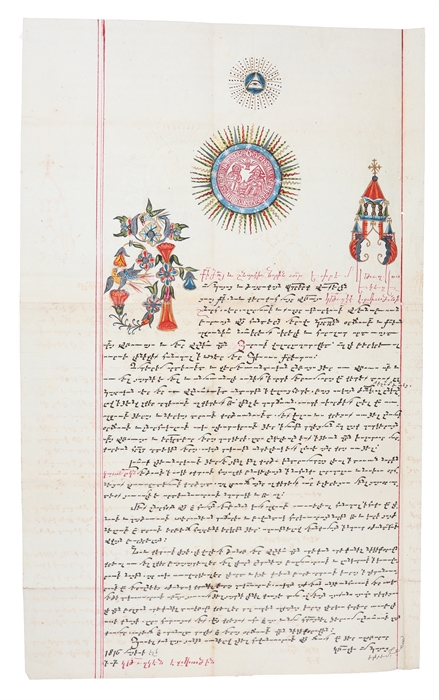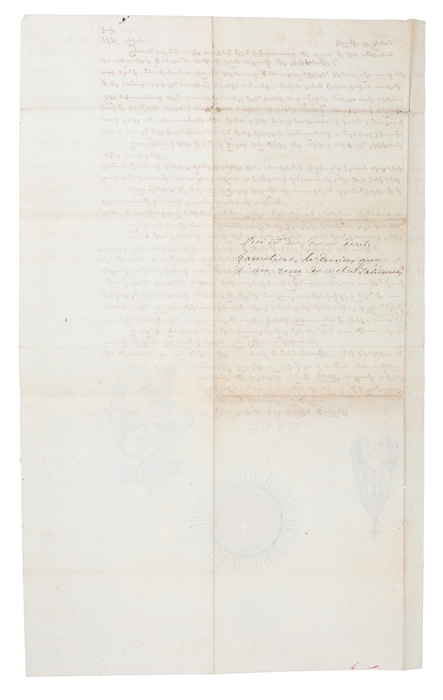LETTER IN ARMENIAN FROM THE CATHOLICOS OF ETCHMIADZIN
YEPREM I (EPHREM), CATHOLICOS OF ETCHMIADZIN.
Letter from the Catholicos of Etchmiadzin, Yeprem I, to a certain Haroutioun, dated 1816.
Armenia, Etchmiadzin, June 7th, 1816.
Folio (405 x 245 mm). All edges gilt. Manuscript-leaf in Armenian (Bologir), ink on paper, single column, 35 lines. Double lined margins in fine gold on the left and one on the right. Text in black and red ink, with two finely painted ecclesiastical emblems in colour: Above a seal of the Holy See of Etchmiadzin; A circular seal surrounded by radiant colored lines and a blue border with white stars. In the centre, an image of the Holy Trinity, used in official documents issued by the Catholicos of All Armenians. Above the All-Seeing Eye in a Triangle, an eye within a triangle, radiating light (stylized with golden rays and dots). This is a widespread Christian and Masonic symbol often called the Eye of Providence or All-Seeing Eye. In Armenian religious iconography, it symbolizes God the Father watching over creation Holy Trinity (the triangle suggests the Father, Son, and Holy Spirit). This symbol is frequently seen in Armenian Church manuscripts, seals and ecclesiastical documents, particularly from the 18th–19th centuries, often influenced by Enlightenment-era Christian art.
Folded. Minor wear at edges, a few tiny holes, overall very well preserved.
An exceedingly rare illuminated Armenian ecclesiastical manuscript letter, issued under the authority of Catholicos Yeprem I Der Movsessian (Ephrem I ) (served 1809–1830), head of the Armenian Apostolic Church. Written at the Mother See of Holy Etchmiadzin, the document formally records the ordination and blessing of a certain cleric named Haroutioun, commending him for his exemplary service to the Church. We have not been able to establish exactly who Haroutioun is. The letter describes him as "the confessing person named Haroutioun, for distinguished service to the Church", which strongly implies ordination or elevation within the clerical ranks - possibly to the priesthood (kahana) or to the rank of vardapet (doctor of theology). He may have been from a regional prelacy or rural diocese since the The Catholicos often issued such documents for clergy being appointed to distant parishes in Persia, the Ottoman Empire or newly annexed Russian territories (Georgia, Karabakh, etc.). What made Yeprem I particularly significant was not a legacy of bold theological innovation or political confrontation, but rather his quiet, deliberate, and pragmatic diplomacy. He inherited a Church fractured by external pressures and internal disputes, still recovering from centuries of divided jurisdiction under Ottoman and Persian rule. In this climate, Yeprem I became a stabilizing figure, reinforcing the authority of Etchmiadzin as the unifying center of the Armenian spiritual world. During his reign, Yeprem I worked to preserve ecclesiastical independence while cautiously cooperating with the Russian state. This was no small feat, as the Russian imperial government sought increasing control over religious institutions in its territories. Rather than provoke conflict Yeprem negotiated space for the Church to function - and even expand - within the framework of Russian imperial protection. His ability to balance loyalty to the Armenian tradition with the practicalities of Russian rule allowed the Church to maintain its institutions, liturgy, and internal governance. One of his most consequential acts was his handling of internal disputes, notably his anathema of Sargis II Hasan-Jalalyan, the rival Catholicos of Aghvank (Caucasian Albania). This decision, issued in 1815, demonstrated his unquestioned canonical authority and his determination to prevent fragmentation of ecclesiastical power. Through such actions, Yeprem I affirmed the exclusive legitimacy of Etchmiadzin and consolidated its role as the supreme authority in Armenian ecclesiastical matters. Though not a prolific writer himself, Yeprem I oversaw the continued copying and preservation of manuscripts at Etchmiadzin and supported the education of clergy. His era saw the groundwork laid for the modest revitalization of Armenian religious learning and a gradual increase in the Church’s influence in civil society - a process that would bear fuller fruit under his successors. Catholicos Yeprem I’s reign was not defined by major reforms or doctrinal controversy, but by his measured guardianship of Armenian ecclesiastical sovereignty during a period of imperial transition. His ability to preserve the independence and integrity of the Armenian Apostolic Church under the looming presence of the Russian Empire makes him one of the more subtle yet significant leaders in the Church’s modern history. Regarding institutional holdings: The Matenadaran and the Archives of the Saint Apostolic Synod of Etchmiadzin hold letters and encyclicals from Catholicos Yeprem I. Outside Armenia, we are aware of only one comparable item: an encyclical from Yeprem I dated 3 August 1813, now held in the British Library (MS 15,957), catalogued by Vrej Nersessian.
Documents of this kind - formally issued and stamped, personally signed and illuminated - were reserved for major ecclesiastical acts and now very rarely appear on the market.
Catholicos Yeprem I served during a pivotal period in modern Armenian history, as the Caucasus was being reshaped by imperial conflict. His tenure coincided with a profound geopolitical transformation in the South Caucasus, marked by the decline of Persian control over Eastern Armenia and the steady expansion of the Russian Empire into traditionally Armenian lands. As head of the Mother See of Holy Etchmiadzin, Yeprem I’s leadership was crucial in navigating the Church through this period of realignment.
His letters and official acts - such as the present - are fine testaments to his pastoral authority and institutional presistene.
Order-nr.: 62506


